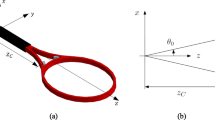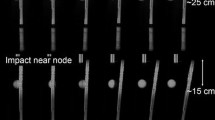Abstract
Background
A number of factors influence the game of tennis. These include different shapes and sizes of the racket and string bed, initial tension in strings, racket-holding techniques, impact force, as well as damping and stiffness of players’ shoulders and wrists.
Purpose
A nonlinear analytical dynamic model of basic tennis actions involving the racket, string bed, and players’ anatomy has been proposed. A dynamic model for the assessment of vibrations induced in players when playing tennis by means of four motions and involving basic parameters concerning the racket and string bed as well as players’ shoulder and wrists is proposed.
Methods
In the proposed model, the racket, string bed, shoulder, and wrists are approximated as a flexible beam, thin membrane, torsional spring, and damping system, respectively. The dynamic model predicts vibration characteristics caused by the action of an impact force on the racket through use of Lagrange’s equation. A governing equation considering four motions is computed using Runge–Kutta techniques. To assess the accuracy of the proposed model, vibrations predicted in the player’s shoulder and racket handle are compared against those obtained via experiments using inertial measurement units (IMUs).
Results
The proposed model represents a method to assess risks associated with the occurrence of injuries when playing tennis and measures to be taken to avoid the same through comparison of proposed-model-predicted results against experimental data and three sets of comparisons.
Conclusions
Conclusions of this study demonstrate that using a small impact force and holding the racket at a greater distance from the butt-end of the grip are useful techniques towards reducing the risk of injuries to the shoulder and wrist, and differences in string tension have a little effect on vibrations set up in the shoulder and wrist.










Similar content being viewed by others
References
Dines JS, Bedi A, Williams PN, Dodson CC, Ellenbecker TS, Altchek DW, Windler G, Dines DM (2015) Tennis injuries: epidemiology, pathophysiology, and treatment. J Am Acad Orthop Surg 23(3):181–189
Hennig EM, Rosenbaum D, Milani TL (1992) Transfer of tennis racket vibrations onto the human forearm. Med Sci Sports Exerc 24(10):1134–1140
Rogowski I, Creveaux T, Triquigneaux S, Macé P, Gauthier F, Sevrez V (2015) Tennis racket vibrations and shock transmission to the wrist during forehand drive. PLoS One 10:e0132925
Marx RG, Sperling JW, Cordasco FA (2001) Overuse injuries of the upper extremity in tennis players. Clin Sports Med 20(3):439–451
Plancher KD, Litchfield R, Hawkins RJ (1995) Rehabilitation of the shoulder in tennis players. Clin Sports Med 14(1):111–137
Mccann DPD, Bigliani LU (1994) Shoulder pain in tennis players. Sports Med 17(1):53–64
Osterman AL (1990) Arthroscopic debridement of triangular fibrocartilage complex tears. Arthrosc J Arthrosc Relat Surg 6(2):120–124
Brody H (1989) Vibration damping of tennis rackets. Int J Sport Biomech 5(4):451–456
King MA, Kentel BB, Mitchell SR (2012) The effects of ball impact location and grip tightness on the arm, racquet and ball for one-handed tennis backhand groundstrokes. J Biomech 45(6):1048–1052
Goodwill SR, Haake SJ (2001) Spring damper model of an impact between a tennis ball and racket. Proc Inst Mech Eng Part C J Mech Eng 215(11):1331–1341
Brody H (1995) How would a physicist design a tennis racket? Phys Today 48(3):26–31
Li F, Fewtrell D, Jenkins M (2004) String vibration dampers do not reduce racket frame vibration transfer to the forearm. J Sports Sci 22(11–12):1041–1052
Banwell GH, Roberts JR, Halkon BJ, Rothberg SJ, Mohr S (2014) Understanding the dynamic behaviour of a tennis racket under play conditions. Exp Mech 54(4):527–537
Hennig EM (2007) Influence of racket properties on injuries and performance in tennis. Exerc Sport Sci Rev 35(2):62–66
Rogowski I, Creveaux T, Faucon A, Rota S, Champely S, Guillot A, Hautier C (2009) Relationship between muscle coordination and racket mass during forehand drive in tennis. Eur J Appl Physiol 107(3):289–298
Brody H (1981) Physics of the tennis racket II: the “sweet spot”. Am J Phys 49(9):816–819
Goodwill SR (2002) The dynamics of tennis ball impact on tennis racquets. The University of Sheffield, Sheffield
Hong Huihui, Han Liang, Perkins NC, Chuan Hu, Barber JR (2017) Nonlinear membrane stiffness model of a tennis racquet string bed. Proc Inst Mech Eng Part P J Sports Eng Technol 232:57–65
Barber JR (1992) Elasticity. Springer, Netherlands
Lee Y, Ashtonmiller JA (2011) The effects of gender, level of co-contraction, and initial angle on elbow extensor muscle stiffness and damping under a step increase in elbow flexion moment. Ann Biomed Eng 39(10):2542–2549
Lee Y, Ashton-Miller JA (2015) Effects of age, gender and level of co-contraction on elbow and shoulder rotational stiffness and damping in the impulsively end-loaded upper extremity. Ann Biomed Eng 43(5):1112–1122
Milner TE, Cloutier C (1998) Damping of the wrist joint during voluntary movement. Exp Brain Res 122(3):309–317
Sinkjær T, Hayashi R (1989) Regulation of wrist stiffness by the stretch reflex. J Biomech 22(11–12):1133
Hirayama O (2010) Homework on the moment of inertia of a human arm. AIP Conf Proc 1263:110–113
Acknowledgements
This project was supported by the Postgraduate Creative Fund of JiangSu Province in China (Grant no. CXLX13-081). The project supported by scientific and technological research program of Chongqing municipal education commission (Grant No. KJ1603004). The research was also supported by the China Scholarship Council (Grant no. 201406090035) and conducted in part at the University of Michigan where the first author (H. Hong) visited during 2014–16.
Author information
Authors and Affiliations
Corresponding author
Additional information
Publisher's Note
Springer Nature remains neutral with regard to jurisdictional claims in published maps and institutional affiliations.
Rights and permissions
About this article
Cite this article
Hong, H., Han, L., Liao, Y. et al. Nonlinear Dynamic Model of Basic Tennis Actions. J. Vib. Eng. Technol. 7, 497–505 (2019). https://doi.org/10.1007/s42417-019-00147-8
Received:
Accepted:
Published:
Issue Date:
DOI: https://doi.org/10.1007/s42417-019-00147-8




